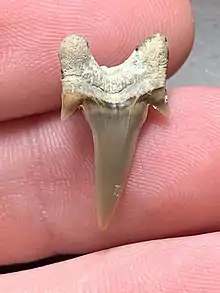Archaeolamna
Archaeolamna is an extinct genus of mackerel shark from the Cretaceous period.[1] There are currently two named species, one of which has two named subspecies. Its isolated teeth have been found in Europe, North America, and Australia. A single associated dentition is known from the Pierre Shale of Kansas, USA.[2] The grasping-type dentition and large size of these teeth suggest a diet of mainly large fish and possibly sea reptiles. There is some evidence of scavenging upon Plesiosaurs in the Judith River Formation.[3]
| Archaeolamna | |
|---|---|
 | |
| Archaeolamna sp. tooth from the Demopolis Chalk of Mississippi | |
| Scientific classification | |
| Kingdom: | Animalia |
| Phylum: | Chordata |
| Class: | Chondrichthyes |
| Order: | Lamniformes |
| Family: | †Archaeolamnidae |
| Genus: | †Archaeolamna Siverson, 1992 |
| Species | |
| |
References
- "elasmo.com". www.elasmo.com. Retrieved 2020-08-22.
- Cook, Todd D.; Newbrey, Michael G.; Murray, Alison M.; Wilson, Mark V. H.; Shimada, Kenshu; Takeuchi, Gary T.; Stewart, J. D. (2011-02-10). "A partial skeleton of the Late Cretaceous lamniform shark, Archaeolamna kopingensis , from the Pierre Shale of western Kansas, U.S.A." Journal of Vertebrate Paleontology. 31 (1): 8–21. doi:10.1080/02724634.2011.539968. ISSN 0272-4634.
- Siverson, M. 1992. Biology, dental morphology and taxonomy of lamni-form sharks from the Campanian of the Kristianstad Basin, Sweden.Palaeontology 35:519–554.
This article is issued from Wikipedia. The text is licensed under Creative Commons - Attribution - Sharealike. Additional terms may apply for the media files.